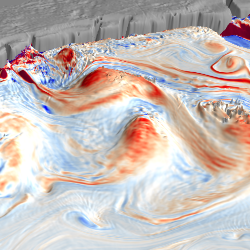 |
Bridging the gap between sub-mesoscales and boundary layer turbulence
15 Oct-11 Nov 2018 Brest (France)
|
|
Abstract Rapid advances in high resolution numerical ocean modeling have lead to substantial increases our understanding of oceanic processes at small scales. The dynamics of processes at scales of less than 30 kilometers, the sub-mesoscales, is characterized by departures from the absolute constraints of the earth’s rotation and ageostrophic effects are significant. The advances in modelling are accompanied by increased capabilities in remote sensing, in-situ observations, and theory. As a result, a picture is emerging of the sub-mesoscales with implications for energy transfers and dissipation, modulation of air-sea, ice-ocean, and ocean-bathymetric interactions, and interaction of coherent structures with the internal tides and internal wave field.
Despite these advances, a gap still exists between the capabilities to model realistic ocean flow on the one hand, and LES of the turbulent boundary layer on the other hand. Bridging this gap requires the relaxation of the hydrostatic assumption, which is still prevalent in most ocean models. As the horizontal resolution approaches the range of O(10 -100 m), the aspect ratio of the simulated flows ceases to be large, and non-hydrostatic effects are eminent. Additionally, three dimensional aspects of subgrid scale turbulent mixing parameterizations, which in ocean models is often ignored, needs to be amended to accommodate the physics of this new flow regime. This workshop aims to advance our collective understanding of oceanic processes at scales of O(10m-1 km), their mechanistic functioning, and relevance for larger scales and the budget of the climate system. These scales span the range between submesoscale dynamics and isotropic boundary layer turbulence.The focus of the workshop is on numerical modeling of these scales, both in the surface layer as well as the bottom boundary layer. In the surface boundary layer, submesoscale may interact with the internal and surface wave field, and can modulate air-wave-sea interactions. In the bottom boundary layer, effects from interactions with topography are expected, including separation and mixing behind headlands, wave emissions, enhanced vertical fluxes of momentum and properties, and form drag.
We invite contributions that discuss novel numerical approaches to bridge this remaining gap in numerical modeling as well as applied studies that target ocean dynamics and its implications at scales in this range.
Topics Topics that will be addressed include:
Keynote speakers
Masterclass The workshop is followed by a two days masterclass, primarily for Students and postdocs. Check-in at the registration. Learning goals:
Material covered:
Planning Thursday 10/18
Friday 10/19
Flyer |

